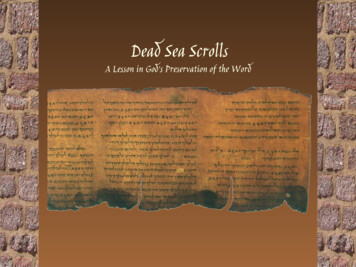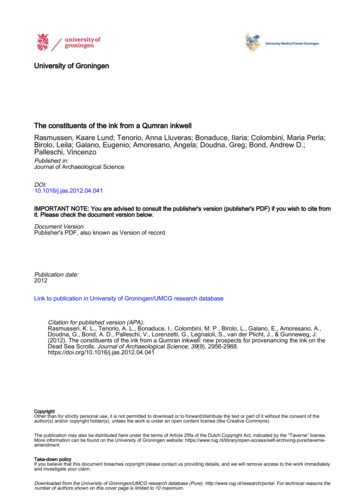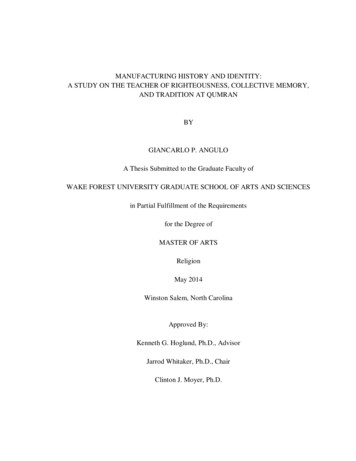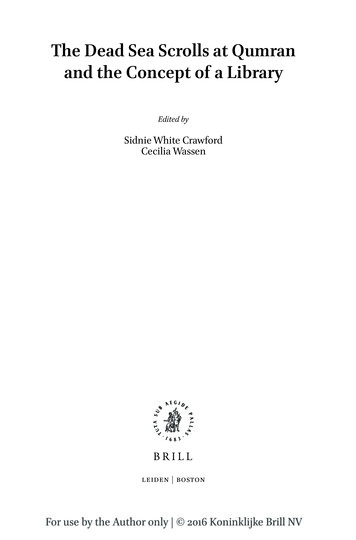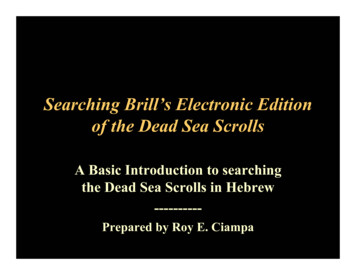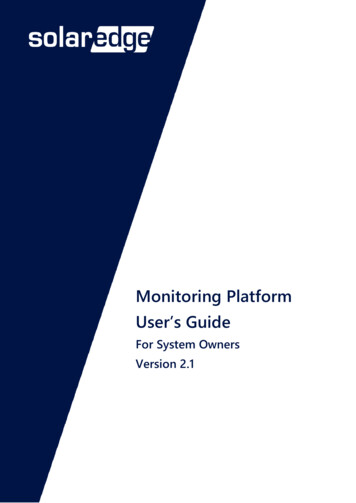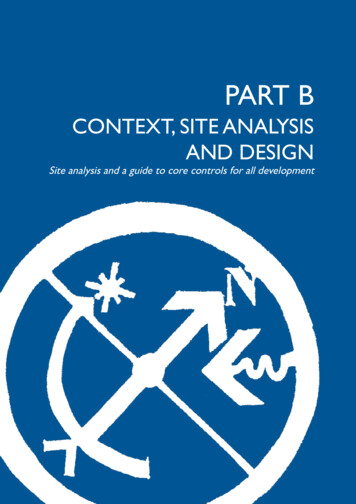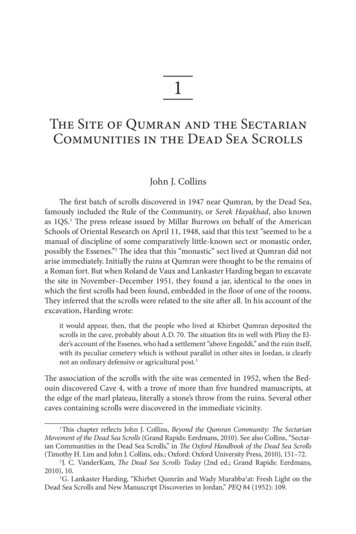
Transcription
1The Site of Qumran and the SectarianCommunities in the Dead Sea ScrollsJohn J. CollinsThe first batch of scrolls discovered in 1947 near Qumran, by the Dead Sea,famously included the Rule of the Community, or Serek Hayakhad, also knownas 1QS.1 The press release issued by Millar Burrows on behalf of the AmericanSchools of Oriental Research on April 11, 1948, said that this text “seemed to be amanual of discipline of some comparatively little-known sect or monastic order,possibly the Essenes.”2 The idea that this “monastic” sect lived at Qumran did notarise immediately. Initially the ruins at Qumran were thought to be the remains ofa Roman fort. But when Roland de Vaux and Lankaster Harding began to excavatethe site in November–December 1951, they found a jar, identical to the ones inwhich the first scrolls had been found, embedded in the floor of one of the rooms.They inferred that the scrolls were related to the site after all. In his account of theexcavation, Harding wrote:it would appear, then, that the people who lived at Khirbet Qumran deposited thescrolls in the cave, probably about A.D. 70. The situation fits in well with Pliny the Elder’s account of the Essenes, who had a settlement “above Engeddi,” and the ruin itself,with its peculiar cemetery which is without parallel in other sites in Jordan, is clearlynot an ordinary defensive or agricultural post.3The association of the scrolls with the site was cemented in 1952, when the Bedouin discovered Cave 4, with a trove of more than five hundred manuscripts, atthe edge of the marl plateau, literally a stone’s throw from the ruins. Several othercaves containing scrolls were discovered in the immediate vicinity.1This chapter reflects John J. Collins, Beyond the Qumran Community: The SectarianMovement of the Dead Sea Scrolls (Grand Rapids: Eerdmans, 2010). See also Collins, “Sectarian Communities in the Dead Sea Scrolls,” in The Oxford Handbook of the Dead Sea Scrolls(Timothy H. Lim and John J. Collins, eds.; Oxford: Oxford University Press, 2010), 151–72.2J. C. VanderKam, The Dead Sea Scrolls Today (2nd ed.; Grand Rapids: Eerdmans,2010), 10.3G. Lankaster Harding, “Khirbet Qumrân and Wady Murabbaʿat: Fresh Light on theDead Sea Scrolls and New Manuscript Discoveries in Jordan,” PEQ 84 (1952): 109.
10The World of Jesus and the Early ChurchOnce the connection between the scrolls and the site of Qumran had beenestablished, it became customary to refer to the community described in 1QS as“the Qumran community,” and to suppose that Qumran was the sectarian settlement par excellence. According to J. T. Milik, this rule was the work of the Teacherand “gave its special character to Qumrân monastic life in the first strict phase ofEssenism.”4 Frank Moore Cross argued that “the term yahad, ‘community,’ seems toapply to the community par excellence, i.e., the principal settlement in the desert.The Qumrân settlement is probably unique, not only in being the original ‘exile inthe desert,’ the home of the founder of the sect, but also in following a celibate rule.”5Cross allowed that it was “possible, but not probable . . . that more than one community could be termed the yahad.”6 Thus the tendency developed to regard Qumran as the setting for all the scrolls, or at least for the community described in 1QS.Another Rule BookAlmost from the beginning, however, it was realized that the situation wasmore complicated than that. It was immediately apparent that there was some relationship between the newly discovered Community Rule and a text that hadbeen discovered in the Cairo Geniza in 1896, which had come to be known asthe Damascus Document (or CD, Cairo Damascus) because of references to anew covenant in the land of Damascus. This document also described a sectarianmovement. Not only were there similarities in the organization of the communities described in the two rule books, but also CD contained several code namesthat now reappeared for the first time in the scrolls. These included “Teacher ofRighteousness,” “sons of Zadok,” and “man of the lie.” The relationship was subsequently confirmed when fragments of the Damascus Rule were found in QumranCave 4.7 In 1955, Burrows wrote:The form of the organization and its rules are found in the Damascus Document andthe Manual of Discipline. We have seen that these two documents have a great deal incommon, though there are sufficient differences to show that they do not come fromexactly the same group. They may represent different branches of the same movementor different stages in its history, if not both.8Milik supposed that the Damascus Rule was a secondary development, drawn upby “a fairly important group” who “left the community at Qumrân and settledin the region of Damascus, without, however, abandoning the priestly charac4J. T. Milik, Ten Years of Discovery in the Wilderness of Judea (trans. John Strugnell;Studies in Biblical Theology 26; London: SCM, 1959), 87.5Frank Moore Cross, The Ancient Library of Qumran (New York: Doubleday, 1958;repr., Sheffield: Sheffield Academic Press, 1995), 71.6Ibid.7J. M. Baumgarten, ed., on the basis of transcriptions by J. T. Milik, with contributionsby S. Pfann and A. Yardeni, Qumran Cave 4. XIII: The Damascus Document (4Q266–273)(DJD 18; Oxford: Clarendon Press, 1996).8Millar Burrows, The Dead Sea Scrolls (New York: Viking, 1955), 230.
The Site of Qumran and the Sectarian Communities in the Dead Sea Scroll 11ter of the movement’s theology, and remaining in communion with the ‘motherhouse.’ ”9 Cross also supposed that 1QS was the older rule and that CD was a secondary development.10More recent scholarship, however, has generally favored the priority of CD.11The Damascus Rule preserves the older, simpler form of community structure,while the Community Rule, or Serek, is more developed. In CD, the admissionprocess requires only a simple oath. This simple process is also found in 1QS5:7c–9a, but it is followed by a much more elaborate, multiyear process in 1QS 6.The Damascus (D) community required the contribution of two days’ salary permonth. The Serek requires full community property. The D rule places restrictions on sexual activity. The Serek does not speak of women or children at all.The Damascus Rule is critical of the Jerusalem temple. The Serek imagines thecommunity as an alternative temple. Each of these cases suggests that the line ofdevelopment was from the more primitive kind of organization found in the Drule to the more elaborate provisions of the Serek. It is not the case that one rulesimply superseded the other. Both were copied throughout the first century BCE.Equally, there is no evidence that the differences between the two rules were dueto a schism. Rather, it appears that within one broad movement some people optedfor a stricter, more demanding form of community life.Multiple SettlementsThe yahad, however, cannot be identified simply with one settlement in thewilderness, “the Qumran community.” We read in 1QS 6:In this way shall they behave in all their places of residence. Whenever one fellow meetsanother, the junior shall obey the senior in work and in money. They shall eat together,together they shall bless and together they shall take counsel. In every place where thereare ten men of the council of the community, there should not be missing amongst them apriest . . . And in the place in which the ten assemble there should not be missing a manto interpret the law day and night, always, one relieving another. (1QS 6:1c–8a)12“The council of the community” cannot be distinguished from “the community”or yahad. The plain meaning of this passage is that the yahad consists of multiple communities, with a minimum of ten members.13 Some scholars have triedto deny this by arguing that the passage refers to members traveling outside ofMilik, Ten Years of Discovery, 90.Cross, The Ancient Library of Qumran, 71 n.2.11P. R. Davies’s The Damascus Covenant: An Interpretation of the Damascus Document(JSOTSup 25; Sheffield: JSOT, 1982) was a pivotal book in this regard. The priority of theCommunity Rule is still defended by Eyal Regev, Sectarianism in Qumran: A Cross-CulturalPerspective (Berlin: de Gruyter, 2007), 163–96.12The passage is attested in 4QSd, although the text is fragmentary.13See John J. Collins, “The Yahad and ‘The Qumran Community,’ ” in Biblical Traditions in Transmission: Essays in Honour of Michael A. Knibb (ed. Charlotte Hempel andJudith Lieu; JSJSup 111; Leiden: Brill, 2005), 81–96.910
12The World of Jesus and the Early Churchcommunity14 or that the “places of residence” are temporary structures. But multiple settlements are just what we should expect if the movement in question is identical with the Essene sect, as most scholars suppose. Josephus writes of the Essenes:“They have no one city, but many settle in each city; and when any of the sectarianscome from elsewhere, all things they have lie available to them.”15 Josephus clearlyassumes that Essenes, apparently of the same order, live in many cities. Similarly,Philo says that the Essenes “live in a number of towns in Judaea, and also in manyvillages and large groups.”16 Scholarship seems to have lost sight of these statementsabout the Essenes when it focuses exclusively on the site of Qumran.The view that that the yahad was an association dispersed in multiple settlements may also shed light on one of the more puzzling aspects of the Qumran rulebooks. The fragments of Cave 4 show that both the D rule and the Serek existed indifferent recensions and that both were copied repeatedly during the first centuryBCE. Sarianna Metso has made a convincing argument that some later copies ofthe Serek preserve earlier redactional stages, while the most developed edition, in1QS, is found in the earliest manuscript.17 Philip Davies has questioned whetherthe rules reflect actual community practice: “If the ‘rule’ is a rule, there can beonly one version in effect at any one time. The paradox obliges us to reconsiderour premises: is 1QS a ‘community rule’ at all?”18 But as Metso has argued, “it wasnot academic interest which motivated the Qumranic scribes in their editorialwork but rather the changes which had taken place in the life and practices of thecommunity.”19 If we bear in mind that there were many settlements of the yahad,however, a new explanation becomes possible. Not all the scrolls found at Qumranwere copied on site. Some may have been brought there from different settlements,which may have been operating with different editions of the Community Rule.20In short, the different forms of the Serek may not have been copied side by sidein the same community but may have been in effect in different communities atthe same time. (This possibility also undercuts the question raised by Davies as to14Sarianna Metso, “Whom Does the Term Yahad Identify?” in Biblical Traditions inTransmission: Essays in Honour of Michael A. Knibb (ed. Charlotte Hempel and Judith Lieu;JSJSup 111; Leiden: Brill, 2006), 213–35.15Josephus, J.W. 2.124.16Philo, Apologia pro Iudaeis 1; G. Vermes and M. D. Goodman, The Essenes Accordingto the Classical Sources (Sheffield: JSOT Press, 1989).17Sarianna Metso, The Textual Development of the Qumran Community Rule (STDJ 21;Leiden: Brill, 1997), 105. This view is disputed by Philip Alexander, “The Redaction Historyof Serek ha Yahad: A Proposal,” RevQ 17 (Milik Festschrift, 1996), 437–53.18Philip Davies, “Redaction and Sectarianism in the Qumran Scrolls,” in Sects andScrolls: Essays on Qumran and Related Topics (South Florida Studies in the History of Judaism 134; Atlanta: Scholars Press, 1996), 151–61, here 157.19Sarianna Metso, “In Search of the Sitz im Leben of the Community Rule,” in TheProvo International Conference on the Dead Sea Scrolls (ed. D. W. Parry and E. Ulrich; STDJ30; Leiden: Brill, 1999), 310.20As suggested by Alison Schofield, “Rereading S: A New Model of Textual Development in Light of the Cave 4 Serekh Copies,” DSD 15 (2008), 96–120; eadem, From Qumranto the Yahad: A New Paradigm of Textual Development for the Community Rule (STDJ 77;Leiden: Brill, 2009).
The Site of Qumran and the Sectarian Communities in the Dead Sea Scroll 13whether the Serek was a community rule at all.) Scrolls from various communitieswould have been brought to Qumran for hiding in time of crisis.Reference to Qumran?Do the DSS, or the Serek in particular, ever refer to a settlement at Qumran?Needless to say, the text never indicates a specific location. It does, however,speak of a group that is to go to the wilderness to prepare there the way of the Lord.From the early days of scholarship on the scrolls, scholars have seen here a specificreference to the settlement by the Dead Sea.The passage is found in 1QS 8. The opening section (8:1–4a) announces thatthere shall be “in the council of the community twelve men and three priests, perfect in everything that has been revealed from all the law” (8:1). This section is followed by three paragraphs, each of which begins with the phrase “when these are inIsrael.” The first of these, beginning in 8:4b, claims for the sectarian group the function of atonement, which was traditionally proper to the temple cult. The secondparagraph begins in 8:12b: “when these are a community in Israel21 . . . they shallbe separated from the midst of the dwelling of the men of iniquity, to go to the wilderness to prepare there the way of Him, as it is written, ‘in the wilderness preparethe way of **** . . .’ This is the study of the law, which he commanded by the handof Moses.” The third paragraph, beginning in 9:3, reads, “when these are in Israelin accordance with these rules in order to establish the spirit of holiness in trutheternal.” This passage is not found in 4QSe, which lacks 8:15–9:11. The paragraphbeginning in 9:3 seems to duplicate 8:4b–10 and may be a secondary insertion.22In the early days of scrolls scholarship, the twelve men and three priestswere understood as an inner council.23 It is not apparent, however, that they haveany administrative role. In an influential article published in 1959, E. F. Sutcliffedubbed them “The First Fifteen Members of the Qumran Community.”24 In thishe was followed by Jerome Murphy-O’Connor, who labeled the passage “an Essenemanifesto.”25 This view has been widely, though not universally, accepted. MichaelKnibb spoke for many when he wrote:This material thus appears to be the oldest in the Rule and to go back to the periodshortly before the Qumran community came into existence; it may be regarded as21The word “( ליחד a community”) is inserted above the line and appears to be missingin 4QSd.22So Sarianna Metso, The Textual Development of the Qumran Community Rule (STDJ21; Leiden: Brill, 1997), 72.23So Milik, Ten Years of Discovery, 100.24E. F. Sutcliffe, “The First Fifteen Members of the Qumran Community,” JSS 4 (1959):134–38.25Jerome Murphy-O’Connor, “La Genèse Littéraire de la Règle de la Communauté,”RB 66 (1969): 528–49. See also Michael Knibb, The Qumran Community (Cambridge Commentaries on Jewish Writings of the Jewish and Christian World 200 BC to AD 200 2;Cambridge: Cambridge University Press, 1988), 129.
14The World of Jesus and the Early Churchreflecting the aims and ideals of conservative Jews who were disturbed by the way inwhich the Maccabean leaders were conducting affairs, and whose decision to withdraw into the wilderness was motivated by the desire to be able to observe strictlyGod’s laws in the way that they believed to be right. It probably dates from the middleof the second century BC.26This view does not withstand a close analysis of the text.The text of 1QS 8:1, “In the council of the community (there shall be) twelvemen and three priests,” can be read in either of two ways. The twelve men and threepriests can be taken to constitute the council of the community or to be a specialgroup within it. It is possible to take the verse to mean that the twelve men andthree priests are a special subgroup within the council of the yahad. (The councilof the yahad is simply the yahad itself). This is in fact how they are understood in1QS 8:10–11: “When these have been established in the fundamental principles ofthe community for two years in perfection of way, they shall be set apart as holywithin the council of the men of the community.” They are not, then, a council inthe sense of an administrative or executive body. Rather, they are an elite group setaside for special training. The establishment of such a group is necessary for thecompletion of the yahad: “when these exist in Israel the council of the communityis established in truth” (8:5). The group in question cannot be taken to constitutethe whole yahad, at any stage of its existence.27 Rather, as Leaney already saw, “thecommunity or movement out of which it arose must have been represented bygroups dispersed throughout the land.”28 The elite group does not break away fromthe yahad, nor does it found a separate organization. It may be said to found a newcommunity, but it is a community that is an integral part of the broader yahad. Thetext (1QS 8:10–11) says quite clearly that certain people who have been establishedin the community for two years will be set apart as holy in its midst. In the extanttext, the antecedent is the group of twelve men and three priests.Unfortunately, we do not know what part this group played in the history ofthe movement. The numbers have symbolic significance, referring to the twelvetribes and three priestly families,29 and we cannot be sure that this group evercame to be. Moreover, the command to prepare in the wilderness the way of theLord is taken from Scripture and is interpreted allegorically in the text:As it is written: In the desert prepare the way of ****, in the wilderness make level ahighway for our God. This is the study of the law which he commanded through thehand of Moses, in order to act in compliance with all that has been revealed from ageto age, and according to what the prophets have revealed through his holy spirit.30Knibb, Qumran Community, 129.See further Collins, “The Yahad and ‘The Qumran Community,’” 88–90; also ShaneA. Berg, “An Elite Group within the Yahad: Revisiting 1QS 8–9,” in Qumran Studies: New Approaches, New Questions (ed. Michael T. Davis and Brent A. Strawn; Grand Rapids: Eerdmans,2007), 161–77.28A. R. C. Leaney, The Rule of Qumran and Its Meaning (London: SCM, 1966), 210–11.29Milik, Ten Years of Discovery, 100.30G. J. Brooke, “Isaiah 40:3 and the Wilderness Community,” in New Qumran Textsand Studies (ed. G. J. Brooke and F. García Martínez; STDJ 15; Leiden: Brill, 1994), 117–32.2627
The Site of Qumran and the Sectarian Communities in the Dead Sea Scroll 15Symbolism does not preclude literal enactment, and the fact that this text wasfound beside an inhabited site in the wilderness is hard to dismiss as mere coincidence. Accordingly, the suspicion persists that the retreat of this pioneering groupto the wilderness marked the beginning of “the Qumran community.” If so, it shouldbe noted that it did not arise from a schism in a parent group and did not by itselfconstitute the yahad but was part of a larger whole. It would also, of course, have tohave grown in size. But while the identification of this group with the founding ofthe Qumran community is attractive, it is by no means certain.If the passage in 1QS 8 does indeed refer to the beginnings of the settlementat Qumran, then that settlement would appear to be an offshoot of the main association, or perhaps a kind of retreat center where people could devote themselvesto the pursuit of holiness to an exceptional degree. There is nothing to suggestthat this settlement would become the headquarters or motherhouse of the sect.Neither, it should be noted, is there any mention of a motherhouse in the Greekand Latin accounts of the Essenes. Pliny writes about an Essene settlement nearthe Dead Sea because he happens to be giving an account of that geographicalregion. He does not indicate any awareness of other Essene settlements. Philo andJosephus, however, emphasize that the Essenes live in multiple locations, with noindication that any one took precedence.31 The passage in 1QS 8, in any case, is tooenigmatic to allow us to deduce much about a settlement in the wilderness, and itshistorical and geographical value remains uncertain.The Date of the MovementIn light of what we have seen, the attempt to correlate the ruins of Qumranwith the life of the sect known from the scrolls appears hazardous. The commonassumption in older scholarship that the Teacher “led his flock to the desert” isunsubstantiated. If 1QS 8 is indeed a reference to “the move to the desert,” thenpresumably the yahad had been in existence for some time before that happened.The only clue to the date of this passage is provided by the paleographic date of themanuscript of 1QS, which has been estimated at 75 BCE, plus or minus twentyfive years, and falls within the same range as Jodi Magness’s date for the foundingof the settlement at Qumran.32 This coincidence, however, only keeps open thepossibility of a reference in 1QS 8. It does not establish its probability.For more than fifty years there has been a consensus that the sectarian movement described in the scrolls developed in the middle of the second century BCE.33This consensus has rested on two main considerations. One is a brief and ellipticPhilo, Apologia pro Iudaeis 1; Josephus, J.W. 2.124.Jodi Magness, The Archaeology of Qumran and the Dead Sea Scrolls (Grand Rapids:Eerdmans, 2002), 68.33For an overview see J. C. VanderKam, “Identity and History of the Community,” inThe Dead Sea Scrolls after Fifty Years: A Comprehensive Assessment (ed. Peter W. Flint andJ. C. VanderKam; 2 vols.; Leiden: Brill, 1999), 2:507–23; Philip R. Callaway, The History ofthe Qumran Community: An Investigation (JSPSup 3; Sheffield: Sheffield Academic Press,3132
16The World of Jesus and the Early Churchnarrative of sectarian origins in CD 1, and the other concerns the conflict betweenthe Teacher of Righteousness and the Wicked Priest, described in the biblical commentaries or pesharim.The passage in CD 1 reads as follows:He left a remnant to Israel and did not deliver it up to be destroyed. And in the age ofwrath, three hundred and ninety years after He had given them into the hand of KingNebuchadnezzar of Babylon, He visited them, and caused a plant root to spring fromIsrael and Aaron to inherit His Land and to prosper on the good things of His earth.And they perceived their iniquity and recognized that they were guilty men, yet fortwenty years they were like blind men groping for the way. And God observed theirdeeds, that they sought Him with a whole heart, and He raised for them a Teacher ofRighteousness to guide them in the way of his heart.It is universally acknowledged that the figure of 390 years is symbolic. (It is derivedfrom Ezek 4:5, where the prophet is told to lie on his left side and bear the punishment of the house of Israel for 390 days, representing the years of the punishmentof the house of Israel.) Nonetheless, most scholars have accepted the number asapproximately correct. This would point to a date in the early second century BCE.Some twenty years then elapsed before the coming of the Teacher. The decisivebreak is usually thought to have been a reaction to the usurpation of the highpriesthood by Jonathan Maccabee in 152 BCE. Jonathan is then identified as the“Wicked Priest” mentioned in the pesharim, or commentaries, on the prophets.The archeology of the site of Qumran, as explained by de Vaux, was thought tolend support to this reconstruction of the history. This consensus was formulatedwith minor variations by Milik, Cross, and Geza Vermes.34But in fact there is no reason to think that the 390 years of CD is any morereliable than Dan 9, which calculates the period from the destruction of Jerusalemto the persecution under Antiochus Epiphanes as 490 years (70 weeks of years; infact the period in question was only about 418 years). As Vermes has pointed out,“all the extant evidence proves that Jews of the early post-biblical age possessed nocorrect knowledge of the length of the duration of Persian rule.”35 The 390 years ofCD 1 is a symbolic number for the period of time between the destruction of Jerusalem and the beginning of the last times. It is probably safe to say that a considerable time had elapsed since the destruction, but the number cannot be pressed toyield even an approximate date.1988), 11–27. The consensus view has been defended recently by Hanan Eshel, The DeadSea Scrolls and the Hasmonean State (Grand Rapids: Eerdmans, 2008), 1–27.34Milik, Ten Years of Discovery, 44–98; Cross, The Ancient Library of Qumran, 88–120;Geza Vermes, Les manuscrits du désert de Juda (1953; 2nd ed.; Paris: Desclée, 1954), 70–104. Compare Geza Vermes, The Complete Dead Sea Scrolls in English (rev. ed.; London:Penguin, 2004), 49–66. Cross identified Simon Maccabeus, rather than Jonathan, as theWicked Priest.35Geza Vermes, “Eschatological Worldview in the Dead Sea Scrolls and in the NewTestament,” in Emanuel: Studies in the Hebrew Bible, Septuagint, and Dead Sea Scrolls inHonor of Emanuel Tov (ed. S. M. Paul et al.; VTSup 94; Leiden: Brill, 2003), 482 n. 4. Compare Eshel, The Dead Sea Scrolls and the Hasmonean State, 31.
The Site of Qumran and the Sectarian Communities in the Dead Sea Scroll 17It has been widely assumed that the usurpation of the high priesthood by theMaccabees was a decisive factor in the formation of the sect.36 The high-priestlysuccession, traditionally within the Zadokite line, had been disrupted during theso-called Hellenistic Reform by Jason (who was from the high-priestly family) andMenelaus (who was not), as reported in 2 Macc 4. After the death of Menelaus,Alcimus held the office for some three years (162–160 or 159 BCE).37 After this,there was a period known as the intersacerdotium, when the office of high priestwas vacant, until Jonathan Maccabee was appointed high priest by the Syrian kingAlexander Balas.38 The members of the yahad are often called “sons of Zadok” inthe scrolls, and the Teacher of Righteousness is sometimes called “the priest.” Manyscholars have assumed that the Teacher and his followers, as Zadokite priests, objected to the usurpation of the office by the Maccabees. This is thought to be thebasis for the enmity between the Teacher and the “Wicked Priest” in the pesharim.But in fact the scrolls never claim that the ruling high priests were illegitimate. Thereasons for separation given in the Damascus Document and 4QMMT concern thecultic calendar and matters of legal observance. At no point is any mention made ofthe legitimacy of the high priest. Neither can the use of the sobriquet “the WickedPriest” in the pesharim be taken to imply that the high priest was illegitimate. Thepesharim often qualify the wickedness of the priest in question, but at no point dothey accuse him of usurping the high priesthood.39 It seems highly unlikely that thisissue would go unmentioned, if it were a major reason for the formation of the sect.If the usurpation of the high priesthood was not a causative factor in the formation of the sect, this removes one of the major reasons for dating the origin ofthe sect to the middle of the second century BCE. It also opens up the possibilitythat the conflict between the Teacher and the Wicked Priest was not the originalrift that caused the separation of the sect, but may have occurred some time later.New light was shed on the question of the origins of the sect by the text called“Some of the Works of the Torah,” 4QMMT, a fragmentary text found in six manuscripts in Qumran Cave 4 (4Q394–399). The first public presentation of this text,at a conference in Jerusalem in 1984, led to a revolution in the study of the scrolls,as it states explicitly that the group represented by the author “have separated ourselves from the majority of the people” because of halakic disagreements.40 Theissues in question are primarily ones of holiness and purity (the holiness of Jerusalem and the “camp,” the purity of liquid streams, sacrifice and tithing, forbidden36This hypothesis was first proposed by Vermes, Les manuscrits du désert de Juda, 79.See J. C. VanderKam, “Identity and History of the Community,” in The Dead Sea Scrolls afterFifty Years: A Comprehensive Assessment (ed. Peter W. Flint and J. C. VanderKam; 2 vols.;Leiden: Brill, 1999), 2:509–10.37See J. C. VanderKam, From Joshua to Caiaphas: High Priests after the Exile (Minneapolis: Fortress, 2004), 226–44.38Josephus, Ant. 13.146. See VanderKam, From Joshua to Caiaphas, 244–50.39Compare Alison Schofield and J. C. VanderKam, “Were the Hasmoneans Zadokites?”JBL 124 (2005): 73–87: “while the community opposed Hasmonean ruler-priests, there is nosurviving indication that they considered them genealogically unfit for the high priesthood” (83).40Elisha Qimron and John Strugnell, eds., Qumran Cave 4: V. Miqsat Maʿase Ha-Torah(DJD 10; Oxford: Clarendon Press, 1994), 59 (Composite text, C 7).
18The World of Jesus and the Early Churchsexual unions, etc.).41 Some twenty issues are cited. A whole section of the text isdevoted to laying out the solar calendar, although this may be a separate documentannexed to 4QMMT secondarily.42 While the scriptural basis of the disputed issuesis not made explicit, it is evidently assumed throughout. The issues raised are “precepts of the Torah.” They are presented by juxtaposing opposing arguments; “wesay” as opposed to “they do.” In all cases the views of the “we” group are stricterthan those of their opponents. The views of the opponents generally correspond tothose attributed to the rabbis in the Mishnah and are consequently thought to bethose of the Pharisees.43 The text concludes:We have written to you some of the precepts of the Torah according to our decision,for your welfare and the welfare of your people
caves containing scrolls were discovered in the immediate vicinity. 1 This chapter reflects John J. Collins, Beyond the Qumran Community: The Sectarian Movement of the Dead Sea Scrolls (Grand Rapids: Eerdmans, 2010). See also Collins, "Sectar-ian Communities in the Dead Sea Scrolls," in The Oxford Handbook of the Dead Sea Scrolls

